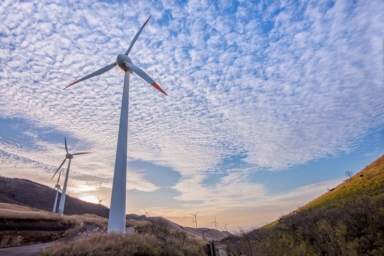Copenhagen Infrastructure Partners develops the first phase of Project Catalina in partnership with Enagás, Naturgy, Fertiberia and Vestas. Project Catalina is a pioneering green hydrogen and green ammonia GW-scale project that aims to bring the abundant renewable resources of Aragon to the industrial consumption points on the Spanish Eastern coast through energy efficient and environmentally friendly infrastructure. Project Catalina intends to develop 5GW of combined wind and solar in Aragon (Spain) and produce green hydrogen through a 2GW electrolyser. Once fully implemented, Catalina will produce enough green hydrogen to supply 30% of Spain’s current hydrogen demand.
Catalina Phase I is currently in an advanced development stage and is expected to be fully developed and permitted in less than two years. Construction is planned to start at the end of 2023. The project will consist of 1.7GW of wind and solar energy facilities as well as a 500MW electrolyser capable of producing over 40,000 tons of green hydrogen per year. It will connect Aragón and Valencia via a pipeline transporting green hydrogen to supply a newly built, state-of-the-art green ammonia plant with annual capacity of 200,000 tons. Green ammonia will be further upgraded into green and sustainable fertilisers within Fertiberia’s existing assets at Sagunto (Valencia), a breakthrough in the decarbonisation of the agriculture industry. The hydrogen produced will also be used for the decarbonisation of other industrial processes and blending into the natural gas grid. Catalina Phase I is applying for grid connection in Andorra (Teruel), at the Mudejar auction, where it will have a large socioeconomic impact in local Municipalities.
Catalina will bring emissions reductions of 1 million tons of CO2e per year in its first phase, and up to 2.5 million tons per year when it reaches full implementation, a reduction during full implementation equivalent to the annual electricity use of nearly 2 million Spanish households.
Project Catalina will make a significant contribution to Spain’s Recovery, Transformation and Resilience Plan (PERTE) on Renewable Energy, Renewable Hydrogen and Storage (ERHA), aimed at positioning Spain as a technology leader in the production and management of green hydrogen.
Engaging with local stakeholders and promoting local socio-economic development is a priority for Catalina. The Catalina consortium members firmly believe in Catalina’s significant contribution to sustainable job creation, R&D, and the promotion of new local value chains, all of which will contribute to boosting the local economy. During construction and installation, Catalina Phase I is expected to create up to 5,000 jobs.
Consortium members have signed a letter of intent committing to work together to realize the Project. The investment required for the project as well as the specific participation of each partner will be approved in due course.
Søren Toftgard, partner at CIP said ”I am very proud to announce Project Catalina, a pioneering initiative in Europe for the large-scale production of green hydrogen and green ammonia. Spain, and in particular Aragon, offers good conditions for the development of this technology due to its excellent solar and wind resource, the political backing as well as the proximity to demand centers. We look forward to continue working with our partners to bring this project to life”.
Marcelino Oreja, CEO of Enagás, pointed out that “This Project to develop green hydrogen in Spain is the result of a common understanding of these international sector leading partners. It reflects our aim to contribute to decarbonization, in a way that is compatible with promoting a competitive industry and job creation, as well as extending the energy transition to all territories, leaving no one behind”.
Jorge Barredo, Managing Director of Renewable Energy, New Business and Innovation at Naturgy said “This new project will be a boost to one of the investment lines of our Strategic Plan and will be added to the other projects we have underway in Spain. At Naturgy we want to be protagonists of the energy transition and hydrogen is one of the essential vectors to achieve a decarbonized economy; that’s why we want to cover the entire value chain, from its production to the final use, and our gas infrastructure is a clear ally to transport it to the consumer sectors”.
Javier Goñi, CEO of Grupo Fertiberia, said “Our participation in Project Catalina allows us to maintain our leadership position in the decarbonisation of the crop nutrition sector in Europe. The green ammonia generated by this consortium will be used as feedstock to produce green fertilisers at the Grupo Fertiberia’s plant in Sagunto, next to industrial uses of this highly efficient carbon free molecule. Sagunto will thus become the Group’s third plant to use a renewable feedstock, after Puertollano and Palos de la Frontera, and will be 100% decarbonized, demonstrating our company’s firm commitment to the ecological transition in the agricultural sector”.
“As a global leader in sustainable energy solutions, Vestas is proud to take part in such a significant and innovative project. We expect Catalina to showcase the huge socioeconomical impact that green power-to-x projects can have not only on the decarbonization of our societies but also in terms of economic growth and employment”, says Vestas vice-president Development EMEA & LATAM, Íñigo Sabater.
